Mark Caney's Blog, page 6
May 1, 2019
Bottlenose dolphin numbers declined by 12% following marine heatwave
An unprecedented spell of marine heat in Shark Bay, Australia, caused bottlenose dolphin numbers to decline for the following six years, a study finds.
Dolphin population numbers fell by up to 12% following the 2011 marine heatwave, says the research. The event also led to a decline in the number of dolphin calves being born.
Previous research has shown that marine heatwaves could become up to 41 times more likely by 2100 under a very high global-warming scenario.
The findings “suggest that the ecological consequences of extreme weather events may be too sudden or disruptive for even highly adaptable animals to respond,” the authors say.
Scorching seas
As with a heatwave on land, a marine heatwave is an extended period of unusually high temperatures.
Research suggests marine heatwaves have become 34% more likely over the past century, with rising global temperatures likely playing a key role in the increase.
In 2011, Shark Bay – a world heritage area in Western Australia famous for its seagrass meadows and unique wildlife – faced an unprecedented marine heatwave. For more than two months, coastal water temperatures soared to 2-4C above average, damaging around 36% of the region’s seagrass meadows. In some regions, almost 90% of seagrasses died.
The extreme heat also killed vast numbers of fish, including commercial populations of scallops and crabs.
The new research, published in Current Biology, explores how this ecological turmoil could have affected a species near the top of the food chain: the bottlenose dolphin.
From 2007-17, researchers monitored groups of dolphins living across a 1,500km area in the bay. The scientists took photographs of each dolphin, allowing them to be identified by their markings and the shape of their fins.
These continuous observations allowed the researchers to keep track of population numbers and the number of new calves being born – both before and after the 2011 event.
Full story: Carbon Brief

Why Whales and Dolphins Join the Navy, in Russia and the U.S.
Fishermen off the northeastern coast of Norway may have spotted the first evidence of a renewed Russian program to use marine mammals for military operations, according to widespread media reports on Tuesday. Last week, local fisherman noticed a beluga whale near their boat that seemed to want their attention. As they got closer, they saw a harness strapped to the beluga, outfitted with mounts for GoPro-type cameras. Further inspection revealed “St. Petersburg equipment” embossed on the harness clips.
Norwegian scientists told reporters that they believed the mammal was trained by the Russian Navy. Russian authorities haven’t commented on the speculation, but it’s unlikely the whale was wearing the harness to record his own home videos.
The use of animals for military operations isn’t all that unusual. During the Cold War, the Soviet navy trained dolphins for military use, but the program was discontinued sometime after 1991. The United States Navy has studied marine mammals, including beluga whales, since the 1960s and has trained them to carry out a variety of tasks, like performing recovery operations and finding underwater mines. The Times reporter John Ismay served as a Navy explosive ordnance disposal officer and explains the kinds of things dolphins, whales and sea lions are trained to do.A bottlenose dolphin searching for an exercise sea mine alongside its Navy trainers in July 2018.CreditU.S. Navy photo
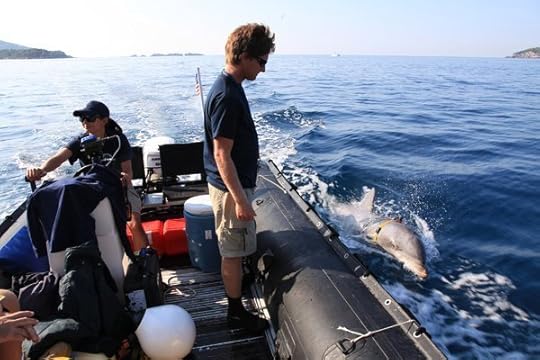
Dolphins? Really?
Yes, as strange as it may sound, the Navy uses dolphins for a variety of missions. The Naval Information Warfare Center, Pacific, trains Atlantic bottlenose dolphins on a base in Point Loma, Calif., while the Navy’s explosive ordnance disposal community uses the mammals for many of its operations. During the summer of 1998, before my senior year at the Naval Academy, I was temporarily assigned to an explosive ordnance disposal unit at Naval Amphibious Base Coronado that had several marine mammal detachments. One looked for trained enemy divers, another looked for naval mines floating in the water column and another searched for mines lying on the seafloor. Another detachment trained sea lions to help recover expensive items like inert torpedoes off the seafloor so that the Navy could reuse them.
Why dolphins?
Two big reasons. One, their bio-sonar is better than any mechanical sonar ever made. Dolphins produce sonar waves from their foreheads, and they can quickly locate things that humans cannot. Second, they can repeatedly dive deeper than human divers, reaching underwater depths that we could otherwise reach only using robots. The dolphins “see” enemy frogmen by sensing sound waves bouncing off the hard calcium deposits in human bones, and can sense mines buried by mud and silt on the seafloor by sensing the air void inside the mine’s casing.You have 2 free articles remaining.Subscribe to The Times
How does the Navy do this?
The dolphins live in netted pens suspended from floating docks near the entrance to San Diego Bay. They are fed a tailored diet of herring and mackerel among several kinds of fish daily. Through positive reinforcement with food and affection, each dolphin is trained to identify specific types of target — such as people, moored mines or bottom mines. When it is time to work, a sailor communicates with the dolphin through a combination of whistles and hand signals. The dolphin then kicks its way up and out of the water, sliding onto a wetted mat laid on the dock. Sailors carry the dolphin to a small motorboat that is cut down to the waterline on one side, which allows the handlers to drive to the search area and slide the mammal gently into the water. They then use a device called a transducer that radiates certain sound tones into the water to signal to the dolphin that it is time to search. Once the dolphin has found its target — either human or a mine — it is brought back into the boat, which then swiftly exits the area so that sailors can take over the mission. For enemy frogmen, that can mean tossing concussion grenades into the water. For mines, bomb disposal divers or remotely operated vehicles go into the water to neutralize or destroy them.
Are they ever trained to kill?
No. That’s a common misunderstanding. You can find rumors all over the internet to the contrary about dolphins being strapped with nuclear warheads for suicide missions, but that has never happened. Their mission is simply to find and mark things, and then exit the area as quickly as possible; there are no weaponized dolphins.
Full story: NY Times

April 30, 2019
Dolphin study suggests marine mammals may experience sexual pleasure
An in-depth study of the dolphin clitoris has revealed that these marine creatures may belong to a small group of animals that are known to experience sexual pleasure.
Dolphins are known to have sex throughout the year, even at times when they are not capable of conceiving.
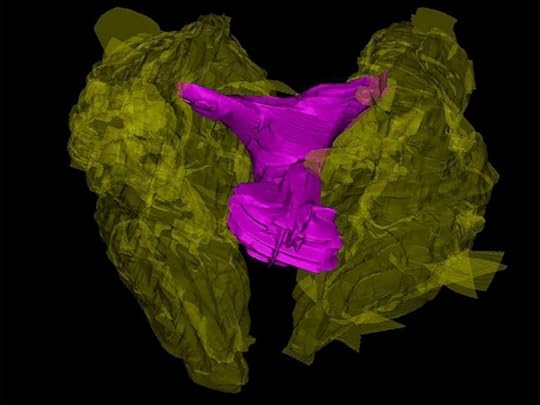 Computer reconstruction of the clitoris of the bottlenose dolphin, which researchers say is remarkably similar to the human clitoris in its structure and shape
Computer reconstruction of the clitoris of the bottlenose dolphin, which researchers say is remarkably similar to the human clitoris in its structure and shapeIn other animals that do this, including humans, sex can be pleasurable for females due in large part to clitoral stimulation.
This led a team of scientists to investigate the genital anatomy of dolphins to determine what enjoyment – if any – the females were getting out of year-round sex.
Dr Dara Orbach of Mount Holyoke College led the research, dissecting and scanning the genitalia of 11 female bottlenose dolphins that had died naturally.
Not only did the animals turn out to have large and well-developed clitorises, anatomically they were remarkably similar to those found in humans.
Scientists noted the skin contained bundles of nerves that may increase sensitivity and potential for pleasure in the animals.
“Our anatomical observations suggest the clitoris is functional in bottlenose dolphins, but further research, including physiological and behavioural analyses, are necessary to test if sexual experiences can be pleasurable for female dolphins,” said Dr Orbach.
She noted that dolphin anatomy was not directly comparable with humans, as the clitoris is positioned at the entrance to the vaginal opening.
“The location of the clitoris near the vaginal opening indicates it can potentially be easily stimulated during copulation,” she said.
Dr Orbach presented her findings at the American Association of Anatomists annual meeting in Orlando.
It is the latest project she was worked on to understand the mysteries of dolphin sex lives. In 2017 she published research detailing how folds in dolphin vaginas can function as barriers to prevent unwanted males successfully mating with them.
Plastic bags and balloons are found in the stomach of rare deep-water baby dolphin
A rare deep-water dolphin that was found stranded on a Florida beach and later had to be euthanized had a stomach full of trash.
Biologists said they found two plastic bags and a shredded balloon during a necropsy of the young rough-toothed dolphin after it washed ashore in Fort Myers Beach last week.
Animal experts said the rough-toothed dolphin was emaciated and in poor health.
Biologists and bystanders worked to help the struggling 11-pound female calf, but wildlife official decided to euthanize the dolphin on-site.
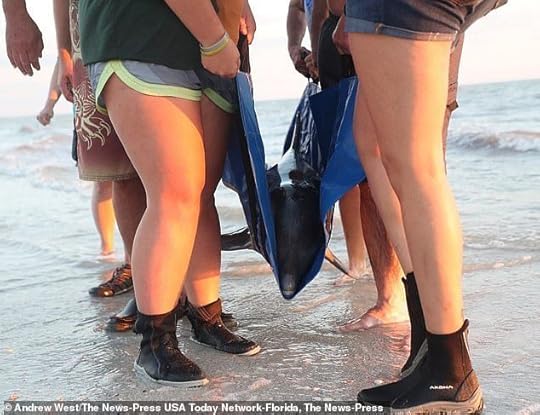
The rare deep-water dolphin was found stranded after it washed ashore in Fort Myers Beach, Florida last week
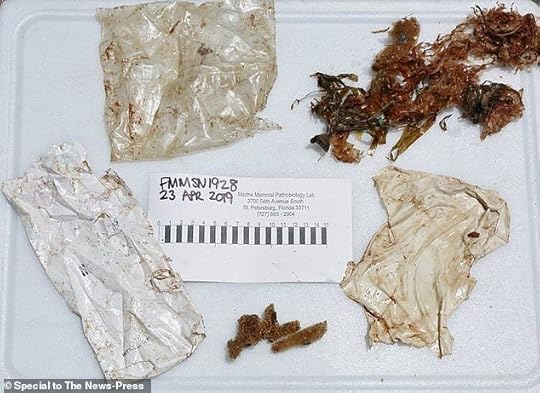
Biologists said they found two plastic bags and a shredded balloon during a necropsy of the young rough-toothed dolphin
Such a young dolphin should have still been with its mother but somehow wound up far from her deep-water home.
Rough-toothed dolphins usually stay in deep water and travel in pods of 10 to 20.
Scientists are still trying to find a cause of death for the dolphin.
‘There are many additional factors to consider, such as underlying illness, disease and maternal separation, before a final cause of stranding and death for the dolphin can be determined,’ the Florida Fish and Wildlife Conservation Commission said.
‘This finding highlights the need to reduce single use plastic and to not release balloons into the environment.
‘Please remember that marine mammals strand for a reason, often the animals are sick or injured.’
Scientists said the samples collected during necropsy would be sent for analysis to help them determine the cause of death.
Full story: Daily Mail

April 28, 2019
Loss of teeth key in whale evolution
Rivalling the evolution of feathers in dinosaurs, one of the most extraordinary transformations in the history of life was the evolution of baleen — rows of flexible hair-like plates that blue whales, humpbacks and other marine mammals use to filter relatively tiny prey from gulps of ocean water. The unusual structure enables the world’s largest creatures to consume several tons of food each day, without ever chewing or biting. Now, Smithsonian scientists have discovered an important intermediary link in the evolution of this innovative feeding strategy: an ancient whale that had neither teeth nor baleen.
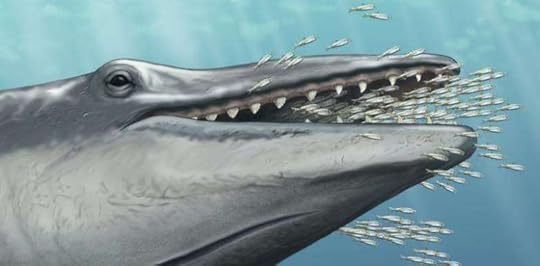 Whales evoloved baleen after losing their teeth
Whales evoloved baleen after losing their teethIn the Nov. 29 issue of the journal Current Biology, scientists at the Smithsonian’s National Museum of Natural History and colleagues describe for the first time Maiabalaena nesbittae, a whale that lived about 33 million years ago. Using new methods to analyze long-ago discovered fossils housed in the Smithsonian’s national collection, the team, which includes scientists at George Mason University, Texas A&M University and the Burke Museum of Natural History and Culture in Seattle, have determined that this toothless, 15-foot whale likely had no baleen, showing a surprising intermediary step between the baleen whales that live today and their toothed ancestors.
“When we talk about whale evolution, textbooks tend to focus on the early stages, when whales went from land to sea,” said National Museum of Natural History’s curator of fossil marine mammals. “Maiabalaena shows that the second phase of whale evolution is just as important for evolution over big scales. For the first time, we can now pin down the origin of filter-feeding, which is one of the major innovations in whale history.”
When whales first evolved, they used teeth to chew their food, just like their land-dwelling ancestors. As time went on, many descendants of these early whales continued to chew their food, inheriting this trait from their predecessors. But as the oceans around them changed and animals evolved, entirely new feeding strategies arose, including baleen filter feeding, says National Museum of Natural History predoctoral fellow Carlos Mauricio Peredo, the lead author of the study who analyzed the Maiabalaena fossils.
Whales were the first mammals to evolve baleen, and no other mammal uses any anatomical structure even remotely similar to it to consume its prey. But frustratingly, baleen, whose chemical composition is more like that of hair or fingernails than bone, does not preserve well. It is rarely found in the fossil record, leaving paleontologists without direct evidence of its past or origins. Instead, scientists have had to rely on inferences from fossils and studies of fetal-whale development in the womb to piece together clues about how baleen evolved.
As a result, it has not been clear whether, as they evolved, early baleen whales retained the teeth of their ancestors until a filter-feeding system had been established. An early initial assumption, Peredo said, was that ocean-dwelling mammals must have needed teeth or baleen to eat — but several living whales contradict that idea. Sperm whales have teeth in their bottom jaw, but none on the top, so they cannot bite or chew. Narwhals’ only teeth are their long tusks, which they do not use for feeding. And some species of beaked whales, despite being classified as toothed whales, have no teeth at all.
Full story: Science Daily

Historic whale and dolphin stranding data made public for the first time
Between 1913 and 1989, the coastguard, fishermen and members of the public sent the Museum their sightings of whale and dolphin strandings from around the UK coast.
Now for the first time this data is being made public, allowing anyone to search the historic cetacean (whale, dolphin and porpoise) strandings records.
Ellen Coombs is studying whale evolution for her PhD at the Museum, and has been delving into the strandings data to see what can be learnt from these historic records as part of a new scientific paper.
‘It is one of the longest systematic cetacean stranding data sets in the world,’ says Ellen.
Between 1913 and 1989, all records of stranded whales and dolphins on UK shores were sent to the Museum. Since 1990, the dedicated UK Cetacean Stranding Investigation Programme (CSIP), funded by the Department for Environment, Food and Rural Affairs, took over the recording of these data, although strandings can still be reported to the Museum. Around the same time, the Irish Whale and Dolphin Group was set up in Ireland to record cetacean strandings there.
In the 106 years represented by the full data set, there have been more than 20,000 reported strandings from 28 different species of cetacean. There are about 90 cetacean species in the world – so roughly a third of them have been spotted in UK waters.
 The first strandings card dates to February 13, 1913, and details a harbour porpoise found on the coast of County Cork © The Trustees of the Natural History Museum, London
The first strandings card dates to February 13, 1913, and details a harbour porpoise found on the coast of County Cork © The Trustees of the Natural History Museum, LondonThe majority of these strandings represent the most common species found in UK waters: the harbour porpoise, short-beaked common dolphin and long-finned pilot whale.
Yet the benefit of strandings records, as opposed to counting living whales and dolphins, is the opportunity to document rarer, shyer and more transient species that may be found around the country.
Hidden among the records are some more unusual sightings, including some of the deepest-diving mammals in the world. Cuvier’s beaked whale has been known to descend 2,992 metres for up to 137 minutes at a time. It’s rarely sighted on the surface, but the species does keep cropping up in the stranding records.
Similarly, while there was a lot of excitement surrounding the appearance of Benny the beluga in the Thames estuary this winter, there are actually two other records of beluga washing ashore in the UK in 1932 and 2014, while in 1949 two narwhals stranded.
Most common whale and dolphin strandings 1913-2015
Harbour porpoise (Phocoena phocoena): 8,265Short-beaked common dolphin (Delphinus delphis): 3,110Long-finned pilot whale (Globicephala melas): 1,606
Minke whale (Balaenoptera acutorostrata): 621
Common bottlenose dolphin (Tursiops truncatus): 595
Atlantic white-sided dolphin (Lagenorhynchus acutus): 565
White-beaked dolphin (Lagenorhynchus albirostris): 539
Striped dolphin (Stenella coeruleoalba): 487
Risso’s dolphin (Grampus griseus): 402
Sperm whale (Physeter macrocephalus): 285
Read full story: Natural History Museum

April 14, 2019
Dolphin brain evolution similar to humans
Whales and dolphins live in human-like societies and share similar brain evolution to primates and man, scientist have concluded.
A new study which looked at 90 species found a link between brain size and social and cultural traits in marine mammals.
It is the first time that scientists have considered whether ‘social brain hypothesis’ applies to whales and dolphins, as well as humans. The theory suggests that intelligence developed as a means of coping with large and complex social groups.
Just like humans, whales and dolphins live in tightly-knit social groups, cooperate with other species, talk to each other and even have regional dialects.
They also engage in cooperative hunting, and pass on their skills to younger members. Some even have signature whistles, which are believed to represent names, so they can call to individuals.
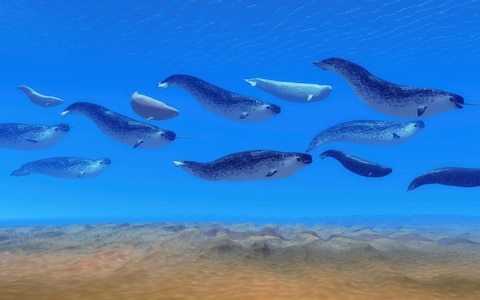 A pod of narwhal whales swim in the Arctic Ocean.
A pod of narwhal whales swim in the Arctic Ocean. The study showed it was possible to predict the brain size of intelligent marine mammals based on the complexity of their social and cultural structures.
The researchers conclude that, just like humans, whale and dolphin cognition may have arisen to cope with the challenges of social living.
Dr Susanne Shultz, an evolutionary biologist in the University of Manchester’s School of Earth and Environmental Sciences, said: “As humans, our ability to socially interact and cultivate relationships has allowed us to colonise almost every ecosystem and environment on the planet.
“We know whales and dolphins also have exceptionally large and anatomically sophisticated brains and, therefore, have created a similar marine based culture.
“That means the apparent co-evolution of brains, social structure, and behavioural richness of marine mammals provides a unique and striking parallel to the large brains and hyper-sociality of humans and other primates on land.
“Unfortunately they won’t even mimic our great metropolisis and technologies because they didn’t evolve opposable thumbs.”
Full story: The Telegraph
Mesmerising drone footage shows whale playing with dolphin pod in Australiah
The study demonstrates that these societal and cultural characteristics are linked with brain size and brain expansion – also known as encephalisation.
Encephalisation, underpins humans’ sophisticated social cognition, including language, joint attention, shared goals, teaching, consensus decision-making, and empathy.

January 6, 2019
Why Scientists Are Starting to Care About Cultures That Talk to Whales
Harry Brower Sr. was lying in a hospital bed in Anchorage, Alaska, close to death, when he was visited by a baby whale.
Although Brower’s body remained in Anchorage, the young bowhead took him more than 1,000 kilometers north to Barrow (now Utqiaġvik), where Brower’s family lived. They traveled together through the town and past the indistinct edge where the tundra gives way to the Arctic Ocean. There, in the ice-blue underwater world, Brower saw Iñupiat hunters in a sealskin boat closing in on the calf’s mother.
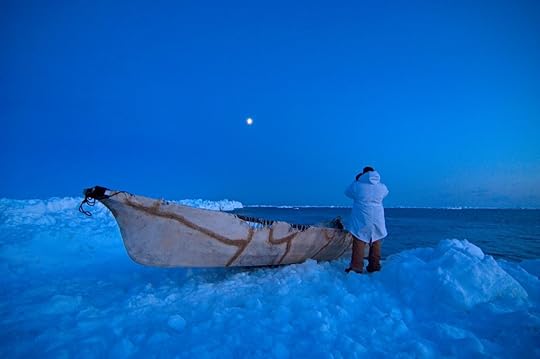 Inupiaq whaler with seal skin umiak waits for passing bowhead whales during spring whaling season Chukchi Sea
Inupiaq whaler with seal skin umiak waits for passing bowhead whales during spring whaling season Chukchi SeaBrower felt the shuddering harpoon enter the whale’s body. He looked at the faces of the men in the umiak, including those of his own sons. When he awoke in his hospital bed as if from a trance, he knew precisely which man had made the kill, how the whale had died, and whose ice cellar the meat was stored in. He turned out to be right on all three counts.
Brower lived six years after the episode, dying in 1992 at the age of 67. In his final years, he discussed what he had witnessed with Christian ministers and Utqiaġvik’s whaling captains. The conversations ultimately led him to hand down new rules to govern hunting female whales with offspring, meant to communicate respect to whales and signal that people were aware of their feelings and needs. “[The whale] talked to me,” Brower recalls in a collection of his stories, The Whales, They Give Themselves. “He told me all the stories about where they had all this trouble out there on the ice.”
Not long ago, non-Indigenous scientists might have dismissed Brower’s experience as a dream or the incoherent ramblings of a sick man. But he and other Iñupiat are part of a deep history of Arctic and subarctic peoples who believe humans and whales can talk and share a reciprocal relationship that goes far beyond that of predator and prey. Today, as Western scientists try to better understand Indigenous peoples’ relationships with animals—as well as animals’ own capacity for thoughts and feelings—such beliefs are gaining wider recognition, giving archaeologists a better understanding of ancient northern cultures.
“If you start looking at the relationship between humans and animals from the perspective that Indigenous people themselves may have had, it reveals a rich new universe,” says Matthew Betts, an archaeologist with the Canadian Museum of History who studies Paleo-Eskimo cultures in the Canadian Arctic. “What a beautiful way to view the world.”
Full story: Smithsonian.com

December 23, 2018
Aquaman and the Dolphins – what’s the truth?
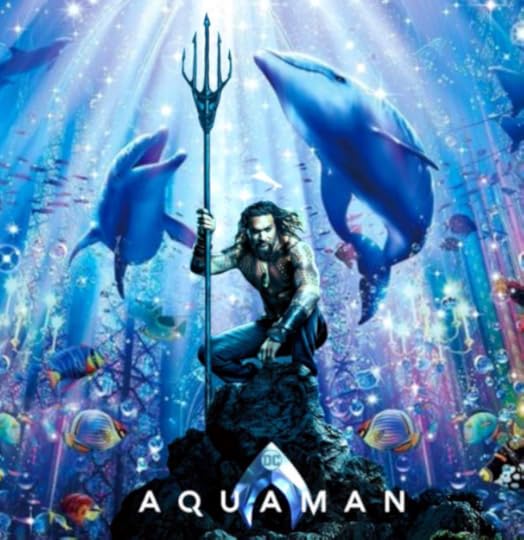 Legendary under-the-sea superhero Aquaman is known for his super strength and speed, telepathic communication with animals, and ability to withstand the ocean depths then return to land with ease. In theaters now, the latest cinematic installment of the DC Universe, Aquaman, promises action-packed excitement, featuring a battle between the heir to Atlantis and his half-brother to prevent war with citizens living on land.
Legendary under-the-sea superhero Aquaman is known for his super strength and speed, telepathic communication with animals, and ability to withstand the ocean depths then return to land with ease. In theaters now, the latest cinematic installment of the DC Universe, Aquaman, promises action-packed excitement, featuring a battle between the heir to Atlantis and his half-brother to prevent war with citizens living on land.
The ocean is Earth’s last frontier, and if Aquaman were real, there are certainly many ways in which he could help the science world. But in his absence, scientists in the real world have to get creative to achieve the feats only a fictional, conveniently-packaged half human-half Atlantean prince can.
Even then, we’ll really never be anywhere near conquering the lonely, vast ocean world—especially since so much of it is under threat. Or as Andrew David Thaler eloquently writes for the blog Southern Fried Science: “The ocean is not ours, and no matter how great our technology, we will never master it as we have mastered land, but Aquaman has.”
Aquaman and the Dolphins
Aquaman’s most unique claim to fame is arguably his ability to talk to animals, mostly marine life. Communication with animals is often a prop in all sorts of magical, fictional worlds. Researchers are always studying how different species of primates, birds, bats and dolphins learn language and communicate.
Dolphins may actually prove to be one of the easiest animals to translate, with some researchers estimating that we’ll be able to understand the beasts using artificial intelligence by 2021, reports Karla Lant for Futurism. A Swedish language technology company called Gavagai AB initially used its AI to conquer 40 human languages, before announcing in 2017 that they’re taking their tech to the animal kingdom. The startup working with a wildlife park to “compile a dictionary of dolphin language,” reports Lant.
That’s not the first time humans have used computers to chat with the intelligent porpoises—in fact, Disney even threw their hat in the ring, receiving a patent in the 1990s. Researchers at the company proposed a keyboard with pictures on each key. The keys produce sounds that, hypothetically, both humans and dolphins would understand.
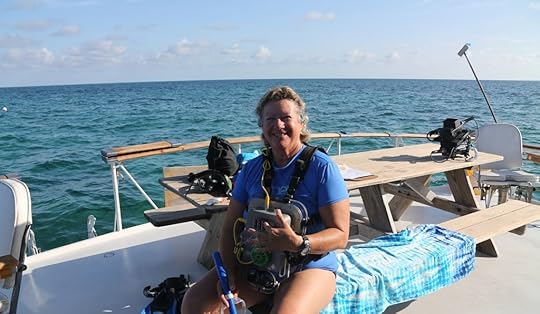 Researcher Denise Herzing wears the Cetacean Hearing and Telemetry (CHAT) device. (Wild Dolphin Project)
Researcher Denise Herzing wears the Cetacean Hearing and Telemetry (CHAT) device. (Wild Dolphin Project)Marine biologist Denise Herzing and her team at The Wild Dolphin Project have been leaders in the field for quite some time. They created the Cetacean Hearing and Telemetry (CHAT) computerized vest to see if it was possible to detect dolphin calls and translate them to English. The device emits a sound that was taught to the pod of dolphins near the Bahamas that Herzing has studied for decades. What does that sound mean? Sargassum, a type of seaweed that divers often use as a toy when playing with dolphins. In 2014, they finally caught a dolphin making the sargassum sounds and CHAT translated it back to English, reports Tuan C. Nyugen for Smithsonian.com. If anything, the project illustrates how smart dolphins are to learn how to communicate with humans in order to get what they want. However, as Herzing tells Nyugen, we don’t exactly know what dolphins say to each other—and that’s okay. Interspecies communication is more the point.
So why might we need it? For starters, the U.S. Navy trains dolphins to search for sea mines, reports Kyle Mizokami for Popular Mechanics.
And who knows what marine life would actually have to say to humans. So much of the sea world is under threat by human hand, including things like warming waters, rising sea level, microplastics, trash, oil drilling, deep sea mining and more.
If Aquaman really could listen to ocean life, he’d probably get an earful.
Read full story: Smithsonian

September 1, 2018
Simply spell binding! Love this book!
A new review of Dolphin Way has just appeared on Amazon:
I happened on this book quite by chance and was somewhat intrigued by the cover details. Clearly with his wealth of marine and environmental experience, the author shouldn’t have any difficulty with his subject, but an environmental message delivered from a dolphin’s viewpoint …. hmmm?
Well, from the first page intrigue reached absorption as I fell (as you will too no doubt) under the spell of “Ocean”.
To have conceived this world in his imagination is amazing but to convey it in all its colours and shapes to the reader with just words and then transport them into that world where fact and fiction combine so skilfully to make it real and believable is, well, quite magical; the magic lying of course in Mr C’s wonderful gift of storytelling. And just as if we don’t want the story teller to stop, we keep turning the pages, eager to reach the end.
So did he deliver? You bet and in such a unique and thought provoking way. And now I just can’t wait for the story to continue.
Highly recommend this book to anyone. Special story in its own right and the message is as current as ever. So if you happen on this book by chance, just get it and read, you won’t be disappointed.
And please someone out there, forget Jaws, The Meg and all the rest, wouldn’t this be so special for all to see up there!
– Janice




